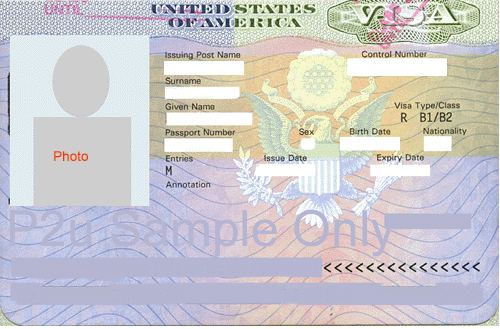Visa vs. I-94: What’s the Difference?
“What’s the difference between my visa and the I-94 landing card?”
“If my visitor visa is good for five years, why can’t I stay in the USA for five years?”
The immigration lawyers at Romben Law, APC in Los Angeles get this type of question all the time. Let’s see if we can’t explain this.

This is basically what a US visa looks like. It has the bearer’s photo, date of birth, nationality, passport number, and validity dates. It also has various codes that tell the border guard what kind of entry is needed, how many entries will be permitted, and so forth. The most important thing is this: a visa give the bearer the right — during the validity period of the visa — to approach the US border and request to be admitted in the category noted on the visa (student, diplomat, investor).
The visa does NOT guarantee admission. The visa does NOT dictate how long of a stay the border guard may grant to you. The visa does not even guarantee in which category (visitor, student, worker, company transferee, investor) the bearer will ultimately be admitted. None of this is dictated or guaranteed by the visa itself. The visa is permission to approach the border.
I-94.pdfThis is the I-94 Arrival-Departure Control Card. All aliens (except US legal permanet residents) are required to fill out the I-94 on the airplane prior to landing at the port of entry (POE). At the POE, the alien presents the I-94 together with passport and visa to the border guard. In most cases — unless the border guard thinks you’re not who you say you are, or that you’ve previously violated US immigration law, or that you are not qualified to be in the visa category listed on your visa — the border guard will swipe your passport and visa into the computer, take your picture and fingerprint, and admit you to the USA in the category appropriate to your visa (E-1 trader, F-1 student, H-1b worker, L-1 company transferee, etc.).
At the POE, the border guard will stamp the passport, stamp the I-94, and endorse the I-94 for the visa category (B-2, F-1, H-4), and write in the expiration date of the authorized stay in the USA. The alien must either exit the USA or seek an appropriate extension of stay (EOS) or change of status (COS) prior to this expiration date.
The length of stay granted by the border guard is a function of (a) established policy, and (b) the whim of the officer. Most officers will grant the “normal” amount of time established for the type of visa. B visaholders typically get 6 months. E visaholders typically get two years — regardless of when their visa expires. H visaholders are typically granted until the expiration of the underlying I-129 petition.
The date written or stamped onto the I-94 governs the alien’s length of stay in the USA — not the visa itself. –jcf
 Immigration Visa Attorney Blog
Immigration Visa Attorney Blog

